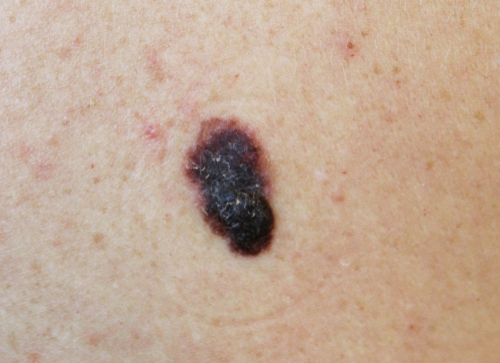By: Robin Gosdin Farrell, DNP, FNP-BC, Associate Clinical Professor, Auburn University College of Nursing
Malignant melanoma occurs when melanocytes mutate and begin to spread. There are 3 predominate types of melanoma: cutaneous, ocular, and mucosal. Cutaneous melanoma (CM) is the most common type of melanoma and the 5th most common cancer diagnosed in the U.S. Cutaneous melanoma accounts for about 1% of all skin cancers but is responsible for most skin cancer deaths with a projected continual increase in incidence over the next decade.1 The diagnosis of CM is often made because of the high visibility of skin lesions. However, CM can also be found below fingernails, where it is called subungual melanoma. Skin cancer risk factors include exposure to ultraviolet (UV) light from the sun or tanning beds where excessive exposure over time is noted. Other risk factors include increasing age, atypical or many moles, large congenital moles (birthmarks), and personal or family history of melanoma.
Mucosal melanoma (MM) is rare and originates from melanocytes within sun-protected mucous membranes. Compared to CM, MM is always internal, it has a poorer prognosis and there are no effective treatment options. Mucosal melanoma is found in the mouth, nasal cavity and sinus passages, intestines, vagina, and anus.2 Symptoms vary based on the location and treatment, but usually involves surgical excision and prevention of recurrence.
Ocular melanoma (OM), the rarest form of melanoma. It is also known as uveal melanoma because of its growth in the uvea, a layer of tissue under the sclera. Ocular melanoma is the most common form of eye cancer with approximately 2,000 cases diagnosed annually in the U.S.3 Individuals at higher risk for OM are those with light skin, blonde or red hair, and blue eyes. Tumor growth can cause floating black spots, light flashes, or loss of eyesight and can often change the shape of the pupil. Approximately 50% of patients with OM will develop metastases within 10 to 15 years of diagnosis.3
Melanoma is difficult to treat due to quick and aggressive metastases, multiple mutations during the growth of the tumor, and tumors that are often surrounded with dormant or exhausted T-cells.4 These characteristics have led to new treatments like immunotherapy,5 which at present has a high success rate. Outcomes also improve when treatment plans include combinations of immunosuppressive medications.
Two checkpoint inhibitor drugs that utilize proteins in the body and are involved with generation of cell activation have been approved. These proteins include programmed death cell protein 1 (PD-1) and its ligand (PD-L1) and cytotoxic T-lymphocyte-associated protein 4 (CTLA-4).6 Combinations can also target specific DNA features such as the BRAF gene, the BRAF protein, and the MEK pathway. Located on chromosome 7, the BRAF gene plays a role in cell growth by transmitting signals outside of the cell to the cell’s nucleus. Mitogen-activated protein kinase (MEK or MAPK) is involved in signal transduction pathways that modulate physiological and pathological cell responses.7 Despite a high side effect profile that includes fatigue, liver inflammation, thyroid issues, and others, combination immunotherapy will improve outcomes among patients being treated for skin cancer over the long haul.5
References
- American Cancer Society. (2019, August 14). About melanoma skin cancer. What is melanoma skin cancer? https://www.cancer.org/cancer/melanoma-skin-cancer/about/what-is-melanoma.html
- American Academy of Ophthalmology (2022). What is ocular melanoma? https://www.aao.org/eye-health/diseases/what-is-ocular-melanoma
- Aim at Melanoma Publications (2022). What is mucosal melanoma? https://www.aimatmelanoma.org/melanoma-101/types-of-melanoma/mucosal-melanoma/
- National Cancer Institute at the National Institutes of Health. (2020, August 25). Melanoma treatment. https://www.cancer.gov/types/skin/patient/melanoma-treatment-pdq
- American Cancer Society (2022, March 22). Immunotherapy for melanoma skin cancer. https://www.cancer.org/cancer/melanoma-skin-cancer/treating/immunotherapy.html
- National Cancer Institute (2021, June 21). Nivolumab and Relatlimab combination shows promise in advanced melanoma. https://www.cancer.gov/news-events/cancer-currents-blog/2021/melanoma-nivolumab-relatlimab-immunotherapy
- Pavlick, A., Zhao, R., Lee, C., Ritchings, C., & Rao, S. (2021). First-line immunotherapy versus targeted therapy in BRAF-mutant malignant melanoma: A real-world analysis. Future Oncology, 17(6), 689-699. https://doi.org/10.2217/fon-2020-0643

